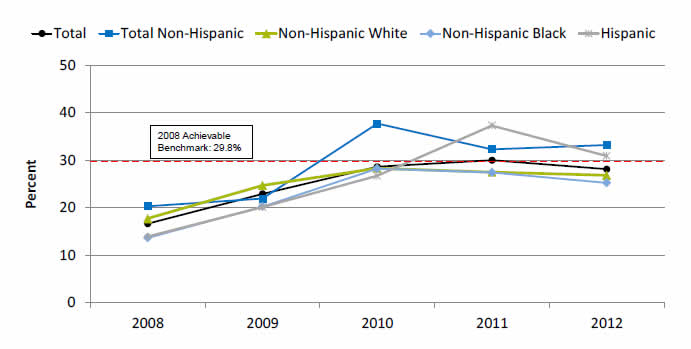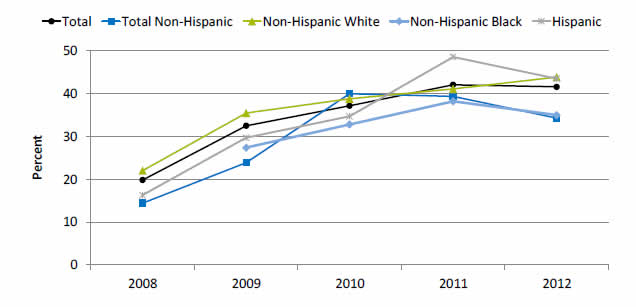HPV Vaccine Among Adolescent Females Ages 13-15
Adolescent females ages 13-15 years who received 3 or more doses of human papillomavirus (HPV) vaccine, by race/ethnicity, United States, 2008-2012

| Race / Ethnicity | 2008 | 2009 | 2010 | 2011 | 2012 |
|---|---|---|---|---|---|
| Total | 16.6 | 22.9 | 28.6 | 30.0 | 28.1 |
| Total Non-Hispanic | 20.3 | 21.9 | 37.7 | 32.3 | 33.2 |
| Non-Hispanic Black | 13.6 | 20.2 | 28.2 | 27.4 | 25.2 |
| Non-Hispanic White | 17.7 | 24.7 | 28.3 | 27.5 | 26.8 |
| Hispanic | 13.9 | 20.1 | 26.7 | 37.3 | 30.9 |
2008 Achievable Benchmark: 29.8%.
Source: Centers for Disease Control and Prevention, National Center for Immunizations and Respiratory Diseases and National Center for Health Statistics, National Immunization Survey—Teen, 2008-2012.
- Importance: A licensed HPV vaccine has been available since 2006. It is recommended by the Advisory Committee on Immunization Practices (ACIP) for routine vaccination of adolescent girls at age 11 or 12 years with 3 doses of either HPV2 or HPV4, which can be started at age 9 years, with catchup vaccinations at later ages for females (13-26 years). The vaccine can be safely coadministered with other routinely recommended vaccines. ACIP recommends administration of all age-appropriate vaccines during a single visit (MMWR, 2010).
- Overall Rate: In 2012, the percentage of adolescent females ages 13-15 years who received 3 or more doses of HPV vaccine was 28.1%.
- Trends:
- From 2008 to 2012, overall, the percentage of adolescent females ages 13-15 years who received 3 or more doses of HPV vaccine improved from 16.6% to 28.1%.
- From 2008 to 2012, the percentage of adolescent females ages 13-15 years who received 3 or more doses of HPV vaccine improved for non-Hispanic Blacks (from 13.6% to 25.2%) and Hispanics (from 13.9% to 30.9%).
- Achievable Benchmark:
- The 2008 top 4 State achievable benchmark for adolescent females ages 13-15 years who received 3 or more doses of HPV vaccine was 29.8%. The top 4 States that contributed to the achievable benchmark are Delaware, New York, Pennsylvania, and Rhode Island.
- At the current rate of change, the total population could achieve the benchmark in less than a year, and non-Hispanic White and Black adolescent females could achieve it within 2 years. Hispanic and total non-Hispanic adolescent females have achieved the benchmark.
HPV Vaccine Among Adolescent Females Ages 16-17
Adolescent females ages 16-17 years who received 3 or more doses of human papillomavirus (HPV) vaccine, by race/ethnicity, 2008-2012

| Race / Ethnicity | 2008 | 2009 | 2010 | 2011 | 2012 |
|---|---|---|---|---|---|
| Total | 19.8 | 32.5 | 37.2 | 42.1 | 41.6 |
| Total Non-Hispanic | 14.4 | 23.9 | 40.0 | 39.4 | 34.3 |
| Non-Hispanic Black | 27.4 | 32.8 | 38.2 | 35.0 | |
| Non-Hispanic White | 22.0 | 35.5 | 38.8 | 41.1 | 43.9 |
| Hispanic | 16.3 | 29.7 | 34.7 | 48.6 | 43.5 |
Source: Centers for Disease Control and Prevention, National Center for Immunizations and Respiratory Diseases and National Center for Health Statistics, National Immunization Survey—Teen, 2008-2012.
Note: Data for non-Hispanic Blacks for 2008 have not been analyzed.
- Overall Rate: In 2012, the percentage of adolescent females ages 16-17 years who received 3 or more doses of HPV vaccine was 41.6%.
- Trends:
- From 2008 to 2012, the total percentage of adolescent females ages 16-17 years who received 3 or more doses of HPV vaccine improved from 19.8% to 41.6%.
- From 2008 to 2012, the percentage of adolescent females ages 16-17 years who received 3 or more doses of HPV vaccine improved for Whites (from 22% to 43.9%), Hispanics (from 16.3% to 43.5%), and total non-Hispanic (from 14.4% to 34.3%).



